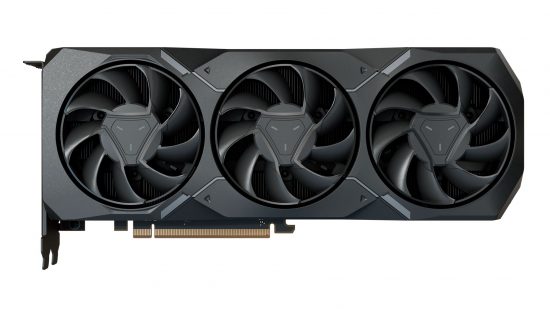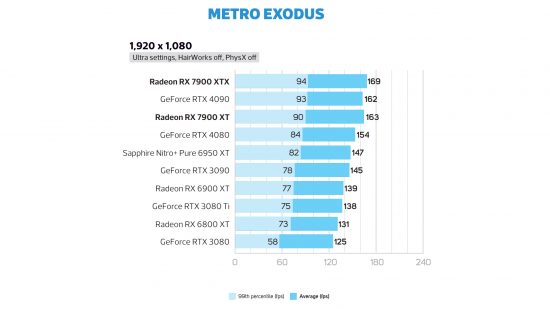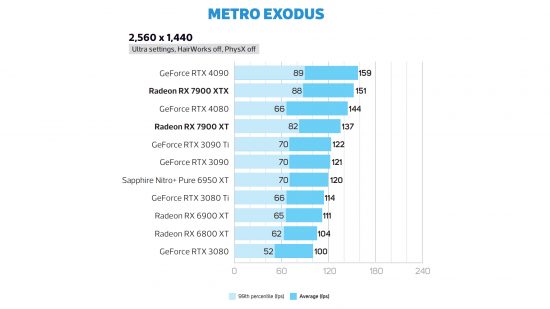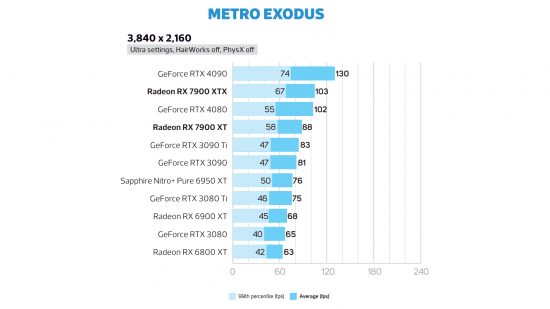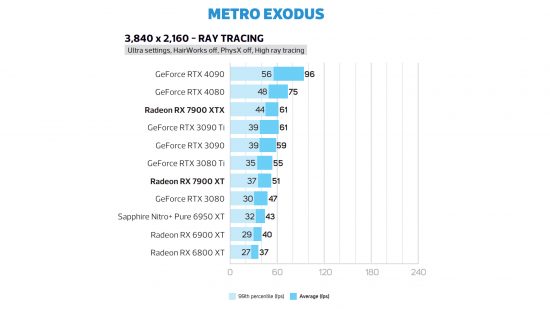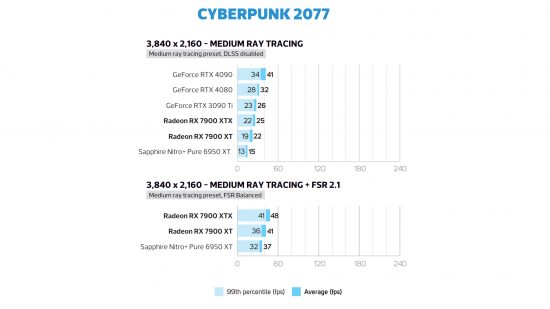Our Verdict
72%Solid gaming performance, but the price is wrong. This would be a winner if it was called the Radeon RX 7800 XT and cost $799, but at $899 it’s too closely priced to the significantly more powerful Radeon RX 7900 XTX.
Based on the same core GPU as its bigger sibling, the AMD Radeon RX 7900 XT gives you a cutdown spec for a saving of $100. That’s not much of a price difference for the drop in spec, but it’s still refreshing to see two top-end GPUs launch below $1,000 in these high-priced times and the Radeon RX 7900 XT is still a potent card.
At Custom PC, we’ve been reviewing the latest gaming GPUs since 2003, and we run a number of grueling benchmarks in order to gauge performance. Our game tests include measuring the frame rate in Cyberpunk 2077, Doom Eternal, and Metro Exodus, all with and without ray tracing, and we also test with Assassin’s Creed Valhalla. For more information, please read our How we test page.
The Radeon RX 7900 XT is based on AMD’s new RDNA 3 architecture, which divides the GPU package into a Graphics Compute Die (GCD), containing all the main processors, and several Memory Cache Dies (MCDs), which contain the L3 cache and memory controller system.
The Radeon RX 7900 XT only has five enabled MCDs, compared with six on the Radeon RX 7900 XTX, which drops the L3 cache down to 80MB from 96MB, and also reduces the width of the memory interface from 384 bits to 320.

It also means the card can only address 20GB of memory, rather than 24GB, but that’s still plenty and it runs at the same 2500MHz (20GHz effective) speed as the memory on the flagship GPU. The result is an overall memory bandwidth of 800GB/sec, which is well behind the 960GB/sec of the Radeon RX 7900 XTX, but still above the 716.8GB/sec of the Nvidia GeForce RTX 4080.
Some of the Compute Units (CUs) on the GCD have also been disabled, giving the Radeon RX 7900 XT 84 CUs compared to 96 on its bigger sibling. Each CU contains a 2nd-generation AMD ray tracing core and 64 dual-issue stream processors, meaning you get 5,376 of the latter in total on the Radeon RX 7900 XT.
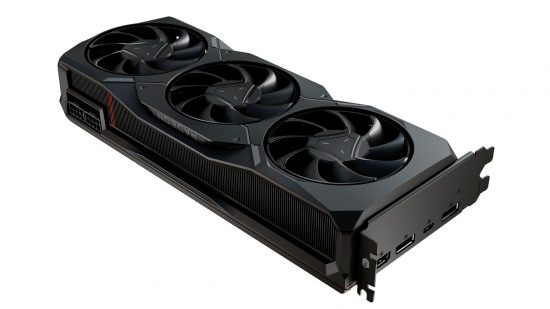
Clock speeds have also been dropped a bit on the 7900 XT, with AMD quoting a typical game clock of 2025MHz and a 2394MHz boost clock. However, as with the Radeon RX 7900 XTX, we found these figures were highly conservative, with the Radeon RX 7900 XT peaking at 2913MHz during benchmarking.
The lower clocks and lesser spec put less of a strain on the cooler than on the Radeon RX 7900 XTX, though. The peak GPU temperature we recorded during testing was 62°C with a top hot spot reading of 78°C, which are similar results to the temperature readings from the GeForce RTX 4080 Founders Edition with its colossal cooler.

AMD Radeon RX 7900 XT performance
Despite its lesser spec, the Radeon RX 7900 XT gets off to a great start in our benchmarks (over the page), beating the GeForce RTX 4090 in Assassin’s Creed Valhalla at 1,920 x 1,080. It also holds its own against the GeForce RTX 4080 in this game at 2,560 x 1,440. It’s only when you up the resolution to 4K that the XT starts to falter, but it’s still not far off the GeForce RTX 4080 here, and it’s well ahead of the Radeon RX 6950 XT and GeForce RTX 3090 Ti.
This game is renowned for preferring AMD’s GPUs, though, so how does it hold up in other games? Moving to Metro Exodus without ray tracing, the Radeon RX 7900 XT is slower than the RTX 4080 at 2,560 x 1,440, but not by a huge margin and it’s well ahead of all the last-gen GPUs. Again, performance drops off at 4K, with its average frame rate dropping by 15fps compared to the XTX, although it’s still perfectly playable on the XT.
Add ray tracing to the mix, though, and the Radeon RX 7900 XT isn’t as convincing. Its average falls behind the last-gen RTX 3090 at 2,560 x 1,440, while still maintaining a solid frame rate, but it drops down to 51fps at 4K, putting it behind the GeForce RTX 3080 Ti and 10fps behind the Radeon RX 7900 XTX.
Likewise, in Cyberpunk 2077 without ray tracing, the Radeon RX 7900 XT held up pretty well, with a cracking average frame rate of 106fps at 2,560 x 1,440 and a still-playable average of 54fps at 4K. Enable the Medium ray tracing preset, though, and it starts to struggle. It can still maintain a decent frame rate at 2,560 x 1,440 if you enable FSR 2.1, but it can’t cope at 4K.
Meanwhile, moving to Doom Eternal showed up the gulf in processing power between the 7900 XT and the XTX, with the former regularly being about 40fps behind its bigger sibling once you get above 1,920 x 1,080. It still coped well with this game at high frame rates, though, even at 4K with ray tracing enabled. It was significantly slower than the RTX 4080 in this test, but it’s still playable. Plus, let’s not forget that the RTX 4080 costs a good £300 more than the Radeon RX 7900 XT.

Finally, we come to the power draw, where our system’s peak draw of 503W with the Radeon RX 7900 XT installed was a good 23W higher than with the RTX 4080 in place. The RTX 4080 has the edge on performance per watt, but the 7900 XT still draws less power than the RTX 3080 Ti.
AMD Radeon RX 7900 XT pros and cons
Pros
- Under £900
- Much faster than Radeon RX 6950 XT
- Standard power connectors
Cons
- Overpriced for spec
- Nvidia Ada GPUs are faster at ray tracing
- Starts to struggle at 4K
AMD Radeon RX 7900 XT specs
The Radeon RX 7900 XT specs list is:
| Stream processors | 5,376 dual-issue |
| RT cores | 84 |
| ROPs | 192 |
| Game clock | 2025MHz |
| Max boost clock | 2394MHz |
| Memory | 20GB GDDR6 |
| Memory clock | 2500MHz (20GHz effective) |
| Memory bandwidth | 800GB/s |
| Memory interface | 320-bit |
| L3 cache | 80MB |
| Card interface | 16x PCIe 4 |
| Power connectors | 2 x 8-pin |
| Card length | 276mm |
| Expansion slots | 2 |
AMD Radeon RX 7900 XT price
The price of the Radeon RX 7900 XT is $899 (£899) making it too close to the price of its bigger sibling for the difference in spec.
Price: Expect to pay $899 (£899)
AMD Radeon RX 7900 XT review conclusion
If the Radeon RX 7900 XT cost $799 USD / £799 GBP this would be a clean run for AMD, but at $899 USD / £899 GBP it muddies the waters to the point where you might as well get the much better performance of the XTX model for just $100 more. It can’t compete with Nvidia’s latest GPUs either, but that’s hardly surprising when they cost so much more money. It’s not far off the pace of the RTX 4080, though, and it’s much quicker than AMD’s previous flagship, the Radeon RX 6950 XT.
If you’re playing games at 2,560 x 1,440, then the Radeon RX 7900 XT is a solid card, even with ray tracing enabled and particularly if you can enable FSR 2.1. However, it starts to struggle at 4K, especially once you add ray tracing to the mix, and the Radeon RX 7900 XTX copes better here. That’s a problem when there’s only a small price difference between the two cards. Arguably, the 7900 XT would be more appropriately named the 7800 XT and have a lower price.
That said, it’s great to see AMD pricing both its two new GPUs under a grand in these times, and the Radeon RX 7900 XT is at least in stock. The Radeon RX 7900 XTX gives you better bang per buck, but the 7900 XT is still a decent choice if you’re looking to play games at 2,560 x 1,440. For more GPU options, check out our best graphics card guide.
Curious to see how this card runs when playing other games? Check out these GPU benchmarks over on the PCGameBenchmark FPS calculator.
